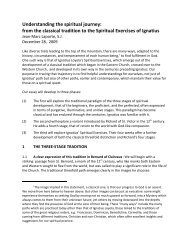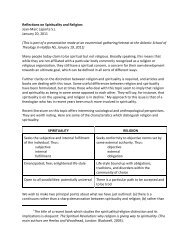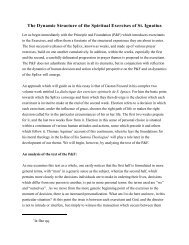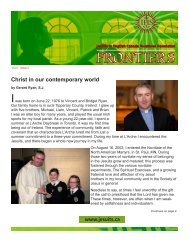A CHRISTIAN TRANSPOSITION OF THE ENNEAGRAM: WITH ...
A CHRISTIAN TRANSPOSITION OF THE ENNEAGRAM: WITH ...
A CHRISTIAN TRANSPOSITION OF THE ENNEAGRAM: WITH ...
You also want an ePaper? Increase the reach of your titles
YUMPU automatically turns print PDFs into web optimized ePapers that Google loves.
Used sensitively and with respect for the person(s) being guided or directed, insights from the<br />
enneagram have had a very positive and liberating impact on the lives of many. The challenge,<br />
however, is two-fold: (1) there are many variations in the way the enneagram is presented, and<br />
there is need to continue empirical research in order to bring more precision to the teaching,<br />
and to better correlate it with psychology and other approaches to human personal<br />
development; (2) there is a need to disengage the enneagram teaching from its esoteric<br />
context, to tease out the elements of truth at its core, to reverse what in it may be wrong or<br />
wrongly expressed, thus transposing its valuable insights into a Christian context. In this essay<br />
we hope to re-express the basic categories of current enneagram teaching in integrally<br />
Christian terms, for example, those found in the letters of Paul and the Exercises of Ignatius.<br />
Detailed descriptions of each of the various “numbers” or enneatypes can be found in standard<br />
books referenced at the end. This is not a complete and self-enclosed handbook but an aide for<br />
Christians engaged in enneagram work.<br />
2 BASIC CATEGORIES FOR <strong>THE</strong> <strong>ENNEAGRAM</strong>: <strong>THE</strong> TOTAL HUMAN BEING<br />
The enneagram teaching sometimes uses terms loosely, in a way unique to itself. We will sort<br />
them out as best we can. The first set of terms have to do with the different components of<br />
the total human being. Since we are attempting to present the enneagram in a way that us<br />
useful for Christian spirituality, we will use the basic categories of Pauline anthropology to<br />
structure our presentation of these terms. The second set of terms will focus on human<br />
consciousness and its gradations. We will take them up in our next section.<br />
2.1 <strong>THE</strong> COMPONENTS <strong>OF</strong> HUMAN NATURE<br />
Presenters of the enneagram make use of many terms to describe human nature and<br />
functioning as they attempt to flesh out the basic structure of the enneagram. Some variants of<br />
enneagram teaching relate it in different ways to contemporary psychology. Other variants<br />
may also relate to contemporary psychology, but their real focus is spiritual, building on the<br />
esoteric mysticism of the original enneagram teachers. Others will make use of commonly used<br />
categories of Christian spirituality and anthropology to present the enneagram. We belong to<br />
this last group, and in our explanation of the enneagram we will draw on Christian<br />
understandings of human nature and growth grounded in categories essentially derived from<br />
the letters of Paul.<br />
2.1.1 A Christian anthropology based on basic Pauline categories<br />
Paul reveals the basic outline of his anthropology in the following passage of his earliest<br />
epistle: “May the God of peace himself sanctify you entirely; and may your spirit and soul and<br />
body be kept sound and blameless at the coming of our Lord Jesus Christ”. (I Thess 5:23). Spirit,<br />
soul, and body: let us comment on each of these components, depicted in the diagram on the<br />
next page, beginning with the one innermost in the diagram. In these comments we will flesh<br />
2










